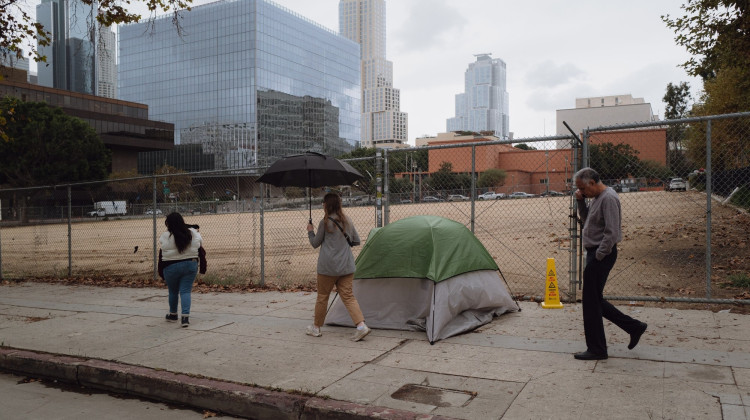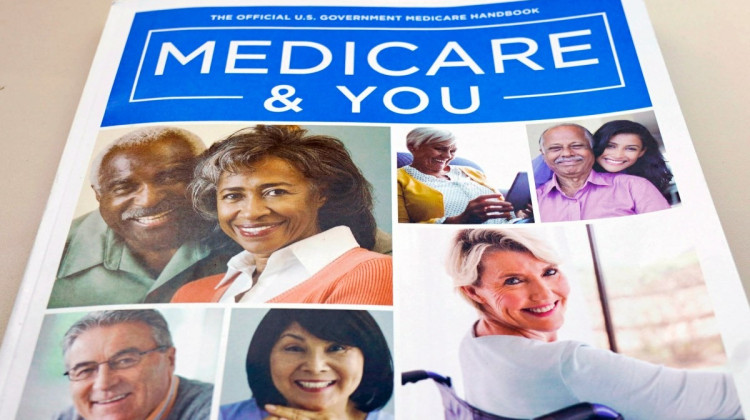
Gov. Eric Holcomb is relaxing COVID-19 restrictions as the number of Hoosiers testing positive and hospitalized with the virus trends down.
Justin Hicks/IPB NewsThe Indiana Department of Health reported 258 additional confirmed deaths over the last week. That brings the state’s total to 9,340 confirmed deaths. The state also reported more than 15,500 new cases in the last week – the fewest weekly reported total since late October.
Indiana has administered 562,084 initial vaccine doses, with 143,683 Hoosiers fully vaccinated.
Here are your statewide COVID-19 headlines from last week.
More Vaccine Expected, But Indiana Not Advancing Distribution To More Age Groups
Indiana officials say the state will begin to receive a slight increase in its number of COVID-19 vaccine doses – but not enough to open up appointments to more people.
Dr. Lindsay Weaver, Indiana Department of Health chief medical officer, said federal officials told the state to expect a boost of about 13,000 doses a week. It currently receives about 80,000 a week.
But the only Hoosiers who can schedule appointments will remain those age 70 and older.
Gov. Eric Holcomb said the state hopes to open appointments to those age 65 to 69 within “days, not weeks.”
READ MORE: How Will Indiana Distribute COVID-19 Vaccines? Here's What You Need To Know
Join the conversation and sign up for the Indiana Two-Way. Text "Indiana" to 73224. Your comments and questions in response to our weekly text help us find the answers you need on COVID-19 and other statewide issues.
Holcomb Relaxes Restrictions As COVID-19 Numbers Improve
Gov. Eric Holcomb is relaxing COVID-19 restrictions as the number of Hoosiers testing positive and hospitalized with the virus trends down.
Beginning next week, the state will continue to use its color-coded, county map to determine gathering restrictions. But it will eliminate 25-person gathering limits in red counties and 50-person limits in orange counties (the two colors indicating the worst amount of spread).
Instead, Holcomb said gatherings in red and orange counties can be up to 25 percent of the facility’s capacity.
Indiana House Version Of COVID-19 Liability Bill Passed By Committee
Indiana businesses and institutions are one step closer to being protected from COVID-19 lawsuits. A House committee passed the bill but some still worry the protections go too far.
Members of the House Judiciary Committee amended House Bill 1002 to try to limit protections to actions taken in response to the pandemic.
However, Ashley Hadler with the Indiana Trial Lawyers Association said the amended bill is still too broad. She wants language that only protects and gives immunity to claims related to exposure to injury due to COVID-19.
“This bill appears to be a solution in search of a problem,” said Hadler. “We have all of the mechanisms required under Indiana law to evaluate these claims currently. What we need in this bill is a tie to COVID-19. We do not have that here.”
Hoosier Lawmaker's Bill Would Prevent Many Future COVID-19 Restrictions
An Indiana lawmaker wants to ban state and local governments from ever again imposing many of the COVID-19 restrictions in place over the last year.
Rep. Bob Morris’s (R-Fort Wayne) legislation would ban state and local governments from limiting a business’s hours of operation or occupancy; regulating what procedures hospitals can do; and requiring mask-wearing or social distancing in a church, unless those things are already in state or federal law.
All of those are executive orders Gov. Eric Holcomb has issued during the pandemic.
The bill also says local health officials can’t close private schools and churches in order to “prevent and stop epidemics.”
A House committee heard the measure Monday but did not vote on it.
New State, Federal Policies Could Alleviate COVID-19 Stress On Latinx Communities
Latinx communities represent a high portion of essential workers, and have also been hit hardest by lost jobs and reduced hours during the pandemic. A group of community leaders and researchers offered some recommendations to address the mental health stressors highlighted by COVID-19.
Gilberto Pérez, Bienvenido Community Solutions president and Goshen city councilor, says in addition to the traditional programs that target mental health, there are other programs the state can implement.
“One of the things that impacts the mental health of our community is the ability to be able to drive safely to work,” Pérez said.
House Bill 1138 and Senate Bill 319 would create driving cards, accessible without having to prove citizenship or lawful status. So far, neither bill has been heard in committee.
"You could say, well, is it really mental health legislation?" Pérez said. "And I would say, to a certain degree, yes it is. Because it is actually providing people an opportunity to get where they need to go, with more calm, more tranquility, more safety."
Virtual School Advocates Seize Opportunity To Voice Funding Frustrations, Parent Sues SBOE
An Indianapolis parent is suing the State Board of Education after it changed a policy to ensure full funding for students learning remotely because of COVID-19. It's part of an ongoing advocacy effort by parents who want virtual schools funded at the same level as brick-and-mortar schools.
Virtual schools get 15 percent less funding per student than in-person schools in Indiana, and the state has been working to circumvent that law and preserve full funding for schools using virtual learning because of the pandemic.
But advocates for virtual schools, including parent Letrisha Weber, are frustrated there's a difference at all.
"It's really sad that so many students are left with a smaller budget simply because they've chosen a school that works better for them," she said.
Meanwhile, lawmakers are continuing to fast-track the virtual funding legislation that would align state law with the board's decision.
The House approved its version of the virtual school funding bill, with a Senate panel approving its version of the measure in a public hearing last Thursday.
Indiana’s December Unemployment Rate Lowest In Midwest
Indiana’s unemployment rate fell to 4.3 percent in December, dropping almost a full percentage point from the month before according to numbers released by the Bureau of Labor Statistics Tuesday morning.
The data shows a surge of more than 80,000 being counted in the labor force – the number of Hoosiers who were working, or actively looking for work last month. The state also reported a 64 percent labor force participation rate.
The new unemployment rate places Indiana as the best in the Midwest for December and remains much lower than the national rate of 6.7 percent.
Contact Lauren at lchapman@wfyi.org or follow her on Twitter at @laurenechapman_.
 DONATE
DONATE








 Support WFYI. We can't do it without you.
Support WFYI. We can't do it without you.